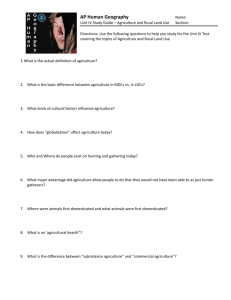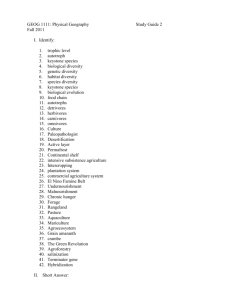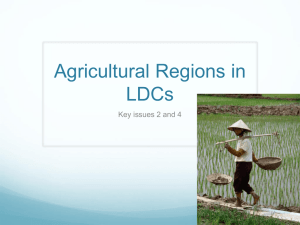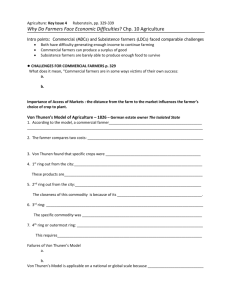Overproduction in Commercial Farming
advertisement
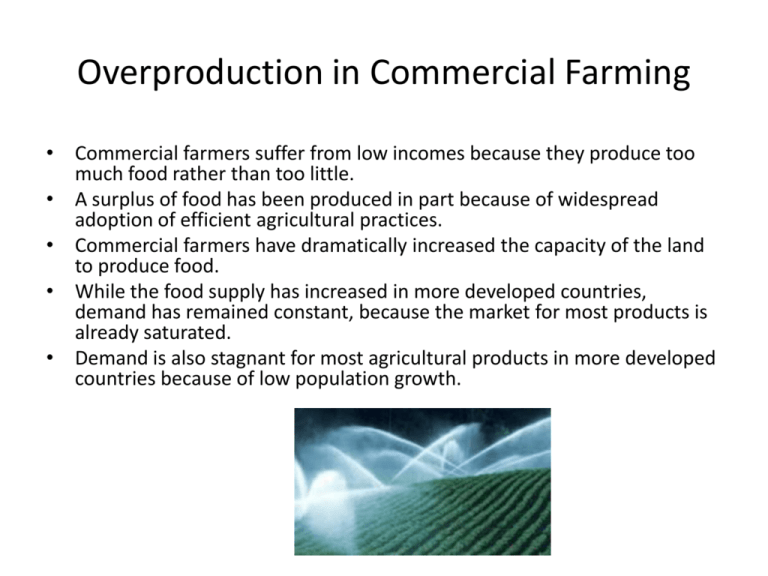
Overproduction in Commercial Farming • Commercial farmers suffer from low incomes because they produce too much food rather than too little. • A surplus of food has been produced in part because of widespread adoption of efficient agricultural practices. • Commercial farmers have dramatically increased the capacity of the land to produce food. • While the food supply has increased in more developed countries, demand has remained constant, because the market for most products is already saturated. • Demand is also stagnant for most agricultural products in more developed countries because of low population growth. U.S. Government Policies The U.S. government has three policies to attack the problem of excess productive capacity. First, farmers are encouraged to avoid producing crops that are in excess supply. The government encourages planting fallow crops. Second, the government pays farmers when certain commodity prices are low. Third, the government buys surplus production and sells or donates it to foreign governments. In addition, low-income Americans receive food stamps in part to stimulate their purchase of additional food. The United States spends about $10 billion a year on farm subsidies. Government policies point out a fundamental irony in worldwide agricultural patterns. In a more developed country such as the United States, farmers are encouraged to grow less food, while less developed countries struggle to increase food production to match the rate of the growth in population. Sustainable Agriculture • Some commercial farmers are converting their operations to sustainable agriculture, an agricultural practice that preserves and enhances environmental quality. • Farmers practicing sustainable agriculture typically generate lower revenues than do conventional farmers, but they also have lower costs. • Two principal practices distinguish sustainable agriculture from conventional agriculture: 1. More sensitive land management 2. Better integration of crops and livestock Sensitive Land Management • • • • • • • • Sustainable agriculture protects soil in part through ridge tillage and limited use of chemicals. Ridge tillage is a system of planting crops on 4-to 8inch ridges that are formed during cultivation or after harvest. Ridge tillage is attractive for two main reasons: lower production costs and greater soil conservation. Production costs are lower with ridge tillage in part because it requires less investment in tractors and other machinery than conventional planting. Ridge tillage features a minimum of soil disturbance from harvest to the next planting. Over several years the soil will tend to have increased organic matter, greater water holding capacity and more earthworms. The channels left by earthworms and decaying roots enhance drainage. Under sustainable agriculture, farmers control weeds with cultivation and minimal use of herbicides. Integrated Crop and Livestock • Sustainable agriculture attempts to integrate the growing of crops and the raising of livestock as much as possible at the level of the individual farm. • Animals consume crops grown on the farm and are not confined to small pens. • Issues for Subsistence Farmers Two economic issues discussed in earlier chapters influence the choice of crops planted by subsistence farmers: first,. . . rapid population growth, (and) second, . . . adopting the international trade approach to development. Subsistence Farming and Population Growth • • • • According to Ester Boserup, population growth compels subsistence farmers to consider new farming. For hundreds if not thousands of years, subsistence farming yielded enough food. Suddenly in the late twentieth century, the LDCs needed to provide enough food for a rapidly increasing population. According to the Boserup thesis, subsistence farmers increase the supply of food through intensification of production, achieved in two ways. – First, land is left fallow for shorter periods. • Bosemp identified five basic stages in the intensification of familand: Forest Fallow; Bush Fallow; Short Fallow; Annual Cropping; and Multicropping. • Eventually, farmers achieve the very intensive use of farmland characteristic of areas of high population density. – The second way that subsistence farmers intensify production, according to the Boserup thesis, is through adopting new farming methods. • The additional labor needed to perform these operations comes from the population growth. Subsistence Farming and International Trade • • • • • • To expand production, subsistence farmers need higher-yield seeds, fertilizer, pesticides, and machinery. For many African and Asian countries the main source of agricultural supplies is importing. To generate the funds they need to buy agricultural supplies, less developed countries must produce something they can sell in more developed countries. In a less developed country such as Kenya, families may divide by gender between traditional subsistence agriculture and contributing to international trade. The more land that is devoted to growing export crops, the less that is available to grow crops for domestic consumption. Rather than helping to increase productivity, the funds generated through the sale of export crops may be needed to feed the people who switched from subsistence farming to growing export crops. Drug Crops • The export crops chosen in some LDCs, especially in Latin America and Asia, are those that can be converted to drugs. • Various drugs, such as coca leaf, marijuana, opium, and hashish, have distinctive geographic distributions. Strategies to Increase Food Supply • Four strategies can increase the food supply: 1. Expand the land area used for agriculture 2. Increase the productivity of land now used for agriculture 3. Identify new food sources 4. Increase exports from other countries Increase Food Supply by Expanding Agricultural Land • Historically, world food production increased primarily by expanding the amount of land devoted to agriculture. • Today few scientists believe that further expansion of agricultural land can feed the growing world population. • Beginning about 1950, the human population has increased faster than the expansion of agricultural land. • Prospects for expanding the percentage of cultivated land are poor in much of Europe, Asia, and Africa. Desertification Hazard Fig. 10-14: The most severe desertification hazards are in northern Africa, central Australia, and the southwestern parts of Africa, Asia, North America, and South America. Increase Food Supply through Higher Productivity • The invention and rapid diffusion of more productive agricultural techniques during the 1970s and 1980s is called the green revolution. • The green revolution involves two main practices: – the introduction of new higheryield seeds – and the expanded use of fertilizers. • The new high yield wheat, rice and maize seeds were diffused rapidly around the world. • India’s wheat production, for example, more than doubled in five years. • Other Asian and Latin American countries recorded similar productivity increases. Increase Food Supply by Identifying New Food Sources. • Scientists have continued to create higher-yield hybrids that are adapted to environmental conditions in specific regions. • The green revolution was largely responsible for preventing a food crisis in these regions during the 1970s and 1980s, but will these scientific breakthroughs continue in the twenty-first century? • The third alternative for increasing the world’s food supply is to develop new food sources. • Three strategies being considered are to cultivate the oceans, to develop higher-protein cereals, and to improve palatability of rarely consumed foods. Grain Importers and Exporters Fig. 10-15: Most countries are net importers of grain. The U.S. is the largest net exporter. Africa’s Food-Supply Crisis • • • • • • Some countries that previously depended on imported grain have become selfsufficient in recent years. Higher productivity generated by the green revolution is primarily responsible for reducing dependency on imports, especially in Asia. In contrast, sub-Saharan Africa is losing the race to keep food production ahead of population growth. By all estimates, the problems will grow worse. Production of most food crops is lower today in Africa than in the 1960s. Agriculture in sub-Saharan Africa can feed little more than half of the region’s population. The Sahel Fig. 10-16: The Sahel, which is south of the Sahara, frequently faces drought and food shortages, as does the Horn of Africa. Chapter 10 Agriculture The End
